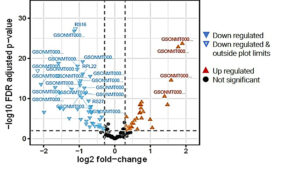Offering deeper insights

Proteomics is analogous to a puzzle
There are many pieces of information, such as the proteins in a cell, their interactions, functions, and modifications. You want to put them together to see the big picture, such as how a cell works, how it responds to stimuli, or how it reacts to disease. Proteomics finds the right pieces and fits them in the right places
MariHealth Solutions is a marine biotech start-up from South Africa, developing solutions for improving fish welfare management. Intensive farming is the main driver of animal stress, with disease outbreaks accounting for 30-80% of losses, making this a US $6bn (£4.7bn) problem globally.
However, current health management practices are reactive – treating disease once symptoms are detected, but offering no pre-emptive data and insight to mitigate stress prior to problems occurring.
To solve this, we use a proteomics platform coupled to a bioinformatics pipeline to analyse blood obtained non-lethally. Through this analytical approach, we can identify protein biomarkers of stress and metabolism, providing a substantially deeper insight into the impacts of farming operations on farmed fish and shellfish.
Ultimately, we enable vets, farms, and fish feed companies to optimise farming operations and nutrition to reduce animal stress and disease outbreaks. MariHealth Solutions seeks to ensure a more sustainable approach to farming seafood by improving production, reducing costs and mitigating feed waste.
Case study
Farmed rainbow trout belonging to two cohorts of different weight, ±350 g and ±1 kg, kept under identical conditions, exhibited 80 proteins that were differentially expressed between the two groups (Fig 1).

Fig 1: Volcano plot depicting the up- and down-regulated proteins following a fold-change analysis of the small fish versus the large fish. Only 25 proteins with the lowest p-value are labelled.
Analysis of the differentially expressed proteins showed that the small fish were actively metabolising, while the large fish were dealing with stress and maintaining homeostasis (Fig 2).

Fig 2: Biological processes upregulated in the small (A) and large fish (B) cohorts.
The study highlighted the difference in growth/metabolism between the two fish cohorts and posed the question: when will the small fish eventually reflect the proteome profile of the large fish? If so, are there interventions that could be implemented that would prolong the “small fish proteome profile”, thus resulting in additional growth of the large fish over time?
The study also showed that it was not economically appropriate for the farm to continue feeding the large fish since they were not increasing in size and faced an increased risk of stress and disease the longer they remained in the raceway. These fish should have been marketed sooner.
The future of proteomics in aquaculture offers innumerable applications and utilities, from disease diagnosis and targeted drug delivery, to biomarker discovery for developing protein arrays and biosensors. Undoubtedly, “omics” technologies are becoming increasingly important in scratching below the surface of fish health and productivity management, particularly in ensuring sustainability in aquaculture.


